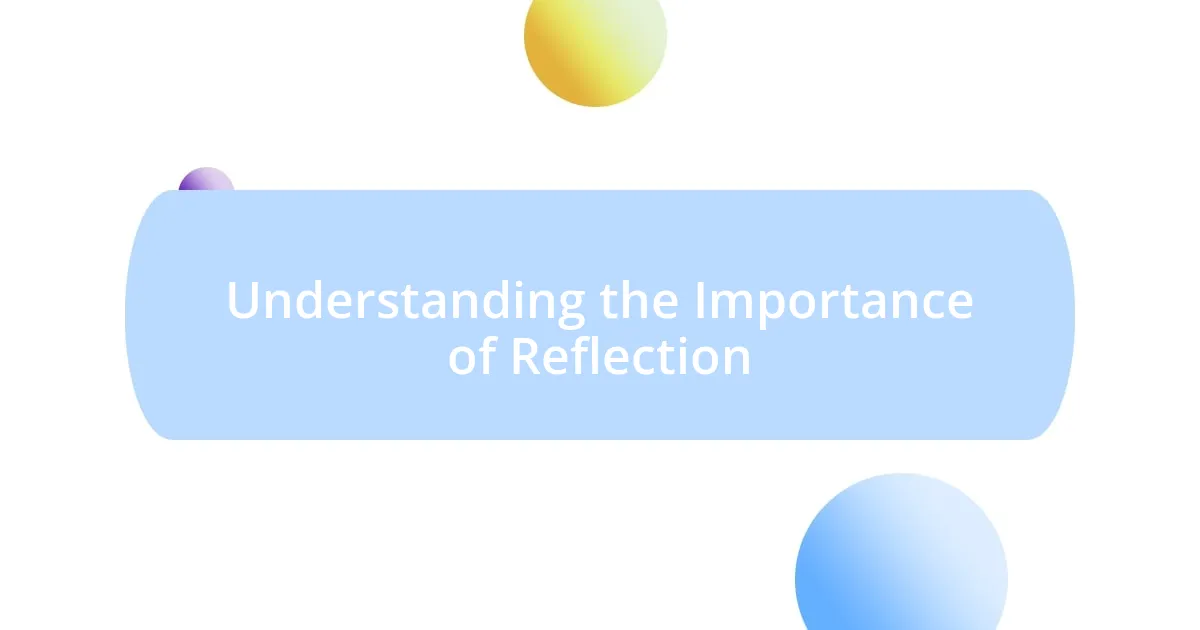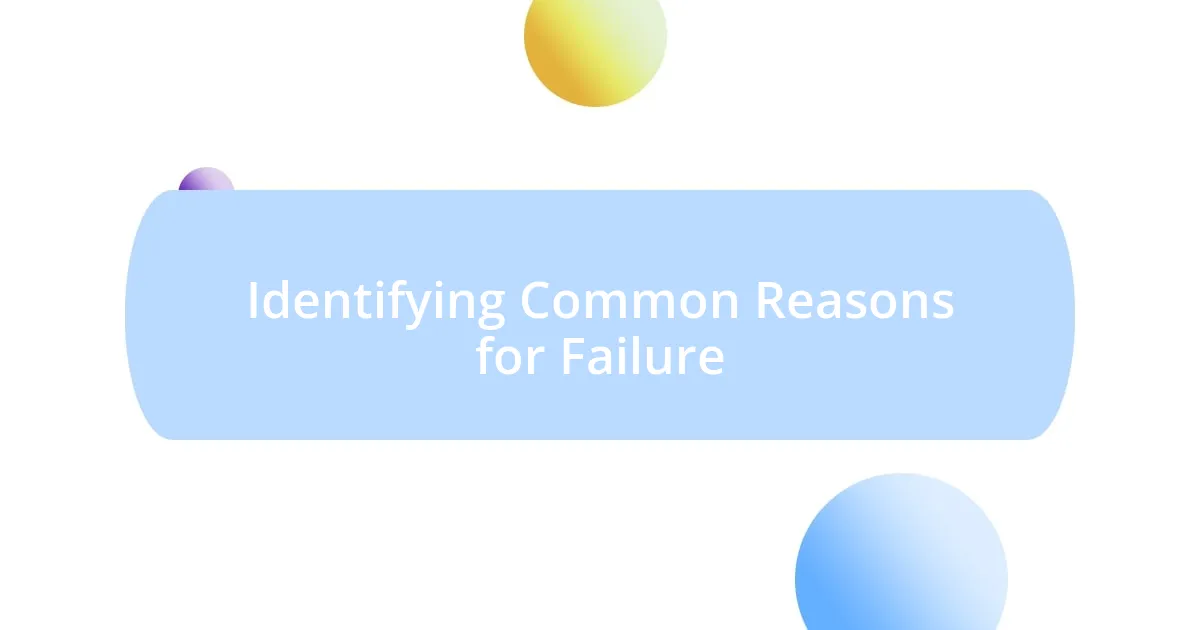Key takeaways:
- Reflection after failures provides clarity and valuable insights for future campaigns.
- Identifying common reasons for campaign failures, such as poor audience targeting and lack of clear objectives, enhances future strategy.
- A/B testing reveals audience preferences, allowing for continual refinement of messaging and strategy.
- Learning from competitor mistakes underscores the importance of integrity in messaging and understanding audience sensitivities.

Understanding the Importance of Reflection
Reflection is not just a passive activity; it’s an active investment in our growth and learning. I remember a campaign I led that missed the mark entirely. In the aftermath, taking a quiet moment to think back on what went wrong provided clarity I hadn’t anticipated. How often do we push through, only to skip the vital step of analyzing our choices?
When I sit down to reflect, I often jot down what I felt during different phases of the campaign. The emotions—frustration, disappointment, or even moments of joy—shape our understanding and pave the way for future success. Have you ever felt a strong gut reaction about a decision but ignored it? I’ve been there, and I’ve learned that those feelings can point to deeper insights waiting to be uncovered.
Ultimately, reflection helps us identify patterns and make meaning from our experiences. I find that revisiting those challenging times creates a roadmap for future endeavors. What would happen if we embraced failure as a teacher rather than a setback? In my journey, I’ve discovered that the lessons learned from reflection can often be more impactful than those from success.

Identifying Common Reasons for Failure
Identifying the common reasons behind campaign failures can be enlightening. After a particularly unsuccessful initiative, I vividly remember sitting with my team and dissecting every element of our approach. We soon realized that poor audience targeting was a key issue. It was like casting a wide net but forgetting to check what fish were actually swimming in the water. Language barriers, mismatched values, and improper channel selection were glaring missteps that cost us valuable engagement.
Here are some common reasons I’ve encountered that often lead to campaign failure:
- Lack of Clear Objectives: Without specific goals, it’s challenging to measure success.
- Inadequate Audience Research: Failing to understand the target demographic can alienate potential supporters.
- Poor Messaging: If the communication doesn’t resonate, it’s likely to be overlooked.
- Ineffective Timing: Launching at the wrong moment can dampen the campaign’s impact.
- Failure to Adapt: Sticking rigidly to a plan despite feedback can prevent needed adjustments.
Reflecting on these points has sharpened my perspective on what to prioritize in future campaigns. Each failed attempt holds valuable lessons that, when reviewed thoughtfully, can steer us toward success.

Analyzing Data from Past Campaigns
Analyzing data from past campaigns has always been a cornerstone of my learning process. I remember when I first started digging into campaign metrics after a disappointing launch. I stumbled upon some key insights hidden in the statistics that I initially overlooked. For instance, analyzing engagement rates versus conversion rates helped me pinpoint where the disconnect was happening. Have you ever been amazed by how numbers can tell a story that raw emotions might miss? It’s fascinating how data can reveal patterns that are not obvious at first glance.
While sifting through the data, I found that segmenting the audience and tracking their behaviors lead to clearer insights. During one campaign, I segmented my audience into groups based on their previous interactions with our brand. This approach unveiled several surprising preferences that directly informed our next steps. By observing trends, I learned to pivot my strategy effectively. Do you realize how much we can learn from our audience’s behaviors? It’s an ongoing journey of discovering what resonates with them.
Moreover, utilizing A/B testing became a game-changer for me. I recall testing different messaging styles during a campaign, and the results were telling. One version of an ad performed exceptionally well, while another fell flat. This experience taught me the critical importance of flexibility and responsiveness to data. What if we set aside our initial assumptions and let the data guide us instead? Trusting the numbers not only enhances our strategy but also builds confidence in decision-making.
| Data Type | Insights Gained |
|---|---|
| Engagement Rates | Identified audience interest areas |
| Conversion Rates | Pinned down the barriers to action |
| A/B Testing Results | Helped refine messaging effectiveness |
| Audience Segmentation | Uncovered diverse audience preferences |

Adjusting Strategies Based on Insights
Adjusting strategies based on insights is crucial for growth. I had an experience during a campaign where we initially targeted a broad audience. After reviewing the feedback, it became painfully clear that we had missed the mark entirely. I still remember the feeling of frustration mixed with clarity as we narrowed our focus, which ultimately led to a more engaged audience and a revitalized approach.
One lesson I learned came from a campaign where we were too attached to our original messaging. After analyzing audience reactions, it was evident that our tone wasn’t resonating. I recall the moment we decided to shift our narrative; it felt like a breath of fresh air. Have you ever experienced that shift when a new idea suddenly clicks? When we embraced the feedback and adjusted our language, engagement skyrocketed, and it taught me the importance of remaining flexible in my strategy.
In another instance, working on campaigns for a local charity, we noticed that our timing was all wrong. I distinctly remember launching during a holiday season when potential donors were preoccupied with their own commitments. Reflecting on that misstep was enlightening; I realized that understanding the audience’s context is just as important as the message itself. Do you see how timing plays a pivotal role in connecting with people? That experience instilled in me a deep appreciation for aligning strategy with audience readiness, ultimately leading to more effective campaigns.

Implementing A/B Testing for Improvement
A/B testing has been a pivotal method in refining my campaigns, and I often think back to one particular instance with two very different subject lines in our email marketing. The first was straightforward, while the other employed a playful tone. Surprisingly, the playful version doubled our open rates! That moment wasn’t just about the numbers. It highlighted how crucial it is to experiment and discover what really resonates with my audience.
After implementing A/B testing, I found that even small changes could yield substantial results. I once tested two different call-to-action buttons on a landing page. One was bold and urgent, while the other was softer and more inviting. The contrast was eye-opening—about a 30% increase in clicks for the bold option. Can you imagine the impact of these tiny tweaks over time? This taught me that each campaign offers a wealth of data, just waiting to be explored.
I also learned that the insights from A/B testing don’t stop at the campaign level; they inform my broader strategy. By understanding which elements captured attention, I’ve been able to tailor future campaigns continually. I remember feeling invigorated as I gathered the insights—I could almost picture my audience’s preferences crystalizing before my eyes. Have you ever felt that thrill of connection when your strategies align with what your audience truly wants? A/B testing equipped me not just with data, but with deeper insights into my audience’s behavior and desires.

Learning from Competitor Mistakes
I’ve always believed that there’s a treasure trove of lessons tucked away in competitor mistakes. For instance, I once observed a rival campaign that overpromised and underdelivered. Their buzz created a lot of initial excitement but crumbled quickly when the audience felt disappointed. It was eye-opening; I realized that integrity in messaging is paramount. Have you ever seen a brand’s reputation suffer because they couldn’t keep their promises? That experience cemented my commitment to transparency in my own campaigns, ensuring that expectations align with reality.
Another valuable lesson came from studying a competitor’s social media blunder. They posted content that, while intended to be engaging, inadvertently alienated a significant part of their audience. I remember shaking my head at the backlash and thinking about my own audience sensitivities. It’s a reminder that understanding your audience isn’t a one-time effort; it’s an ongoing conversation. Have you ever faced a backlash from your audience? That incident reinforced my approach to audience research, ensuring that I not only listen but truly understand the nuances of their perspectives.
Then there was a case where a competitor struggled to adapt their content to different platforms. They posted lengthy articles on social media channels where bite-sized content thrived. Watching their engagement plummet was a lesson in format and context. I felt a sense of relief knowing I had embraced platform-specific strategies early on. Did their mistake ever make you question your own content strategies? This taught me to be agile, adjusting content to suit the unique vibe of each platform, ultimately creating more engaging and relatable campaigns.














